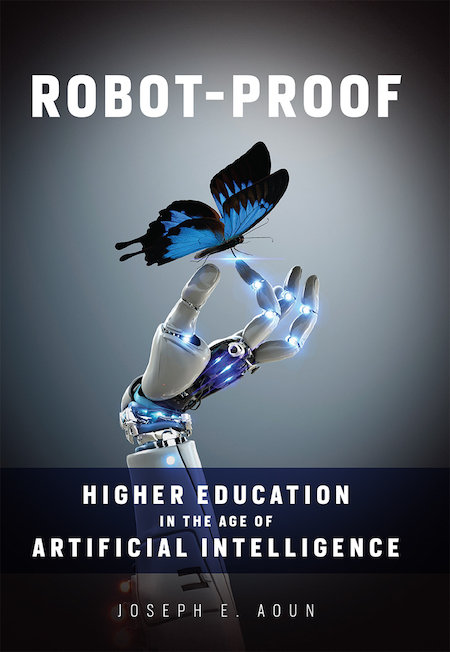The advancement of artificial intelligence means more high-skilled jobs are within the capability of smart machines. How should higher education adapt to prepare students to thrive in this new and fast-changing economy?
Northeastern University President Joseph E. Aoun explores this challenge in his new book, Robot-Proof: Higher Education in the Age of Artificial Intelligence. Below is an excerpt from the book that addresses the rise of A.I., higher education’s transformation, and the future of work.

Chapter 4
We have seen that when learners put their knowledge into practice in real-life situations, they develop a better understanding of themselves, their strengths and weaknesses, and their drives and possibilities. They also sharpen their cognitive capacities, leading to the robot-proof qualities of creativity and mental flexibility—both aspects of far transfer. By contrast, no computer has yet displayed creativity, entrepreneurialism, or cultural agility. And although machines are continually improving in their ability to map knowledge onto recognizable problems—in other words, improving in their near transfer abilities—they cannot perform far transfer well, at least not in the infinite contexts of real life.
Some enterprising machines in the future might launch their own financial services consultancy, resolve a fraught negotiation over intellectual property between American and Chinese lawyers, or post an original video that garners a hundred million likes. But they have not done these things yet, and they do not appear to able to do so anytime soon. Human beings need to use their robot- proof cognitive capacities for those purposes. In other words, our potential to master far transfer is our competitive advantage over intelligent machines.
Practicing far transfer stretches not only the mind but also the mindset. Psychologist Carol Dweck has articulated a concept of mindset that cuts to the core of why experiential learning is powerful. According to Dweck, people respond to situations with either a “fixed mindset” or a “growth mindset.” The fixed mindset is unable to view adverse contexts as anything but impediments. In this mindset, people believe that their qualities and capabilities are set and immovable. Their thinking is rigid: you are either intelligent, outgoing, or good at math, or you’re not. This mindset is reinforced in schoolchildren when we punish failure by awarding bad grades. In many traditional classrooms, the swing between punishment and reward teaches kids to value success and affirmation above anything else. They learn to see setbacks not as opportunities but as personal failures. People stuck in this mindset tend to believe that circumstance is a fence that cannot be breached. They think that great artists, athletes, and scholars are born that way or get lucky. It is a constrained point of view that consequently limits people’s potential.
A growth mindset, on the other hand, believes you can change the contexts in which you find yourself—even simply the context of your own thinking. Personal qualities are mutable. From this point of view, adversity is not a negative context but an opportunity for learning and improvement. For example, you may not be particularly outgoing, but you can choose to step up and make the introductions at a cocktail party. You may not be good at math right now, but you can keep practicing your calculus problems.
Growth mindsets see that natural talent and circumstance are not anchored contexts but are merely starting points from which to improve. People with a growth mindset possess the conviction that they can, though effort and diligence, change their abilities. They become self-reliant. This is of obvious use in converting setbacks into future successes, although people with this mindset do not see success as merely winning. To them, the real value in any context is the opportunity to learn.
In other words, the growth mindset posits that in general, situations, contexts, and the state of one’s own learning are not inherently good or bad. Their value lies in how we think about them. The growth mindset is essential to nurturing the cognitive capacities of critical thinking and systems thinking because both demand that students cast the nets of their minds on wide, and often unexplored, waters. And it is the key to becoming the most robot-proof person of all—the self-directed, lifelong learner.
Dweck observes that this mindset is also the foundation of some- thing else. “In a poll of 143 creativity researchers,” she writes, “there was wide agreement about the number one ingredient in creative achievement. And it was exactly the kind of perseverance and resilience produced by the growth mindset.” Indeed, we already have glimpsed this in our earlier discussion of divergent versus convergent thinking. The questions that arise, then, are how do you teach students to identify when they are stuck in a fixed mindset, spinning their wheels, and what sort of mental boost will push them back onto the track of the growth mindset?
Classroom instruction can help. Evidence shows that simply pointing out the idea of mindsets to students compels them to take notice of it and make efforts to change. But reading about Dweck’s theory in a traditional learning context is not sufficient. To exercise the growth mindset and build a student’s creativity, she has to experience using it. She has to learn by doing.
Experience is the catalyst for the suprarational aspects of learning. By experiencing different situations and contexts, we trigger our emotions, challenge our beliefs, and test the fabric of our minds. These almost subconscious elements of thinking spur our minds to grow—and these subconscious elements cannot be mimicked by computer processors. Deep learning in machines works by scanning data for patterns. Experiential learning in humans works through exposure to the full universe of stimuli. The outcomes are as complex and incalculable as the effects of a rainstorm on a woodland or the flow of water through a riverbed.